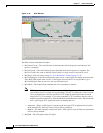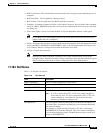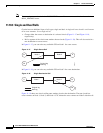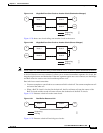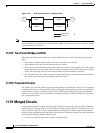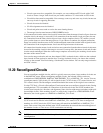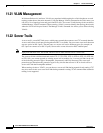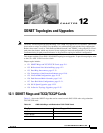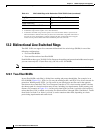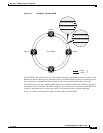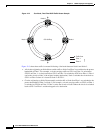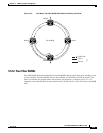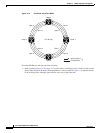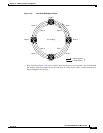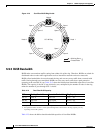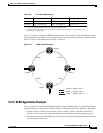
12-2
Cisco ONS 15454 Reference Manual, R7.0
78-17191-01
Chapter 12 SONET Topologies and Upgrades
12.2 12.2 Bidirectional Line Switched Rings
12.2 Bidirectional Line Switched Rings
The ONS 15454 can support five concurrent bidirectional line switch rings (BLSRs) in one of the
following configurations:
• Five two-fiber BLSRs
• Four two-fiber and one four-fiber BLSR
Each BLSR can have up to 32 ONS 15454s. Because the working and protect bandwidths must be equal,
you can create only OC-12 (two-fiber only), OC-48, or OC-192 BLSRs.
Note For best performance, BLSRs should have one LAN connection for every ten nodes in the BLSR.
12.2.1 Two-Fiber BLSRs
In two-fiber BLSRs, each fiber is divided into working and protect bandwidths. For example, in an
OC-48 BLSR (Figure 12-1), STSs 1 to 24 carry the working traffic, and STSs 25 to 48 are reserved for
protection. Working traffic (STSs 1 to 24) travels in one direction on one fiber and in the opposite
direction on the second fiber. The Cisco Transport Controller (CTC) circuit routing routines calculate
the shortest path for circuits based on many factors, including user requirements, traffic patterns, and
distance. For example, in Figure 12-1, circuits going from Node 0 to Node 1 typically travel on Fiber 1,
unless that fiber is full, in which case circuits are routed on Fiber 2 through Node 3 and Node 2. Traffic
from Node 0 to Node 2 (or Node 1 to Node 3) can be routed on either fiber, depending on circuit
provisioning requirements and traffic loads.
UPSR with SDCC 34
1
UPSR with LDCC 14
2
UPSR with LDCC and SDCC 26
3
1. Total SDCC usage must be equal to or less than 84 SDCCs.
2. Total LDCC usage must be equal to or less than 28 LDCCs.
3. Total LDCC and SDCC usage must be equal to or less than 84. When LDCC is provisioned, an
SDCC termination is allowed on the same port, but is not recommended. Using SDCC and LDCC on
the same port is only needed during a software upgrade if the other end of the link does not support
LDCC. You can provision SDCCs and LDCCs on different ports in the same node.
Table 12-1 ONS 15454 Rings with Redundant TCC2/TCC2P Cards (continued)
Ring Type Maximum Rings per Node



